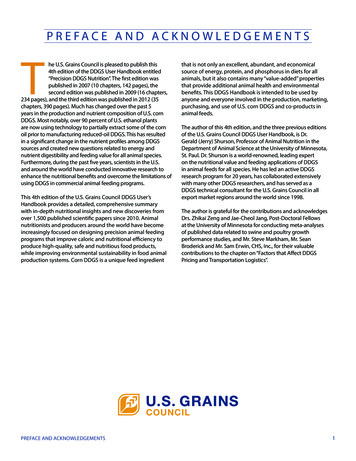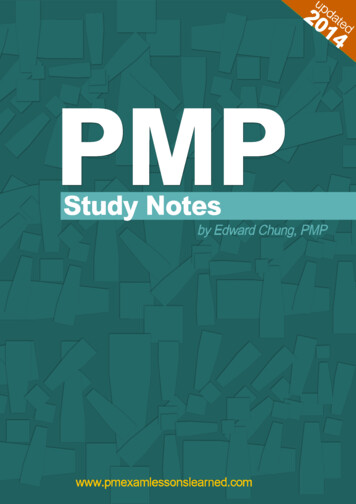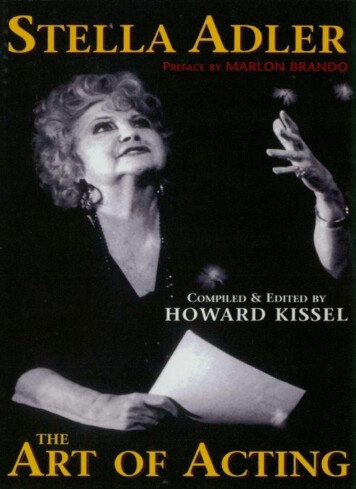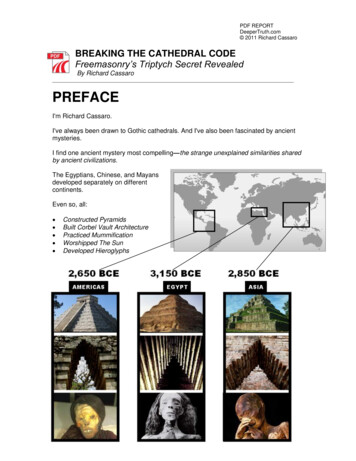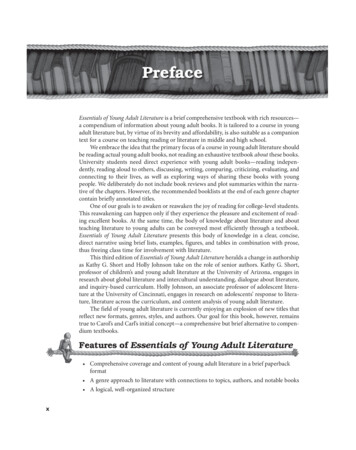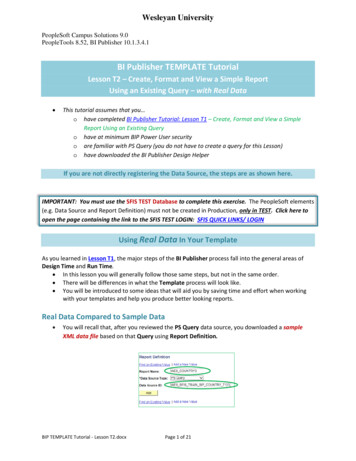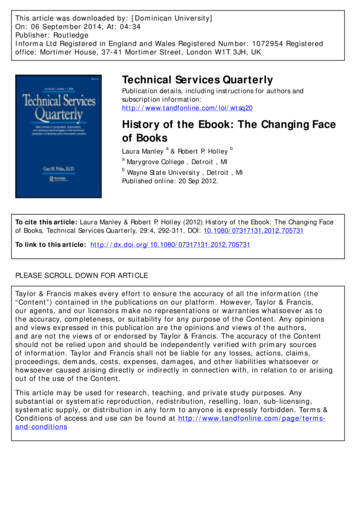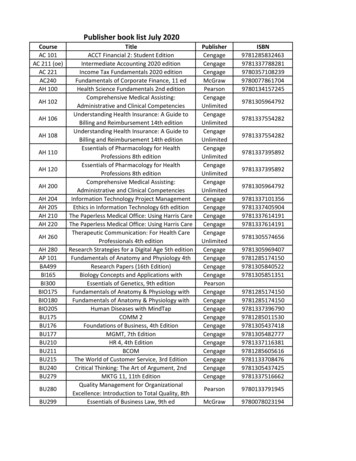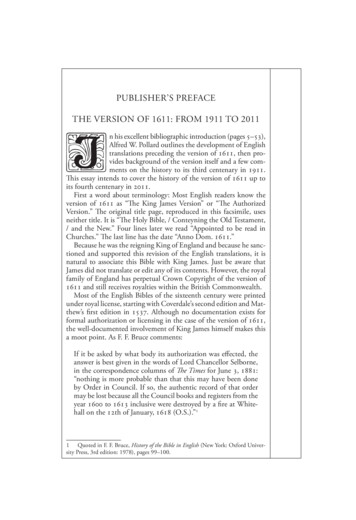
Transcription
PUBLISHER’S PREFACEThe version of 1611: From 1911 to 2011n his excellent bibliographic introduction (pages 5–53),Alfred W. Pollard outlines the development of Englishtranslations preceding the version of 1611, then provides background of the version itself and a few comments on the history to its third centenary in 1911.This essay intends to cover the history of the version of 1611 up toits fourth centenary in 2011.First a word about terminology: Most English readers know theversion of 1611 as “The King James Version” or “The AuthorizedVersion.” The original title page, reproduced in this facsimile, usesneither title. It is “The Holy Bible, / Conteyning the Old Testament,/ and the New.” Four lines later we read “Appointed to be read inChurches.” The last line has the date “Anno Dom. 1611.”Because he was the reigning King of England and because he sanctioned and supported this revision of the English translations, it isnatural to associate this Bible with King James. Just be aware thatJames did not translate or edit any of its contents. However, the royalfamily of England has perpetual Crown Copyright of the version of1611 and still receives royalties within the British Commonwealth.Most of the English Bibles of the sixteenth century were printedunder royal license, starting with Coverdale’s second edition and Matthew’s first edition in 1537. Although no documentation exists forformal authorization or licensing in the case of the version of 1611,the well-documented involvement of King James himself makes thisa moot point. As F. F. Bruce comments:IIf it be asked by what body its authorization was effected, theanswer is best given in the words of Lord Chancellor Selborne,in the correspondence columns of The Times for June 3, 1881:“nothing is more probable than that this may have been doneby Order in Council. If so, the authentic record of that ordermay be lost because all the Council books and registers from theyear 1600 to 1613 inclusive were destroyed by a fire at Whitehall on the 12th of January, 1618 (O.S.).”11 Quoted in F. F. Bruce, History of the Bible in English (New York: Oxford University Press, 3rd edition: 1978), pages 99–100.KJVPreface-8.indd 78/27/2009 10:36:31 AM
viiiPublisher’s PrefaceMaintaining and Publishing the Version of 1611 up to 2011The version of 1611 (hereafter the KJV) is the standard by whichall other English Bible translations are measured. However, until theadvent of modern photo-mechanical printing processes and digitaldata archiving, no two printings of the KJV were precisely the same.English spelling was fluid in the sixteenth and seventeenth centuriesand even a pronoun as simple as the masculine singular could bespelled “he,” “hee” or “hie.” Printers, often scholars in their own right,saw no problem in changing spelling and punctuation as they typesettheir editions. This practice of intentional changes, as well as the introduction of unintentional errors, led to significant official revisionsin the last three centuries. As Pollard notes in his introduction:It must be remembered that no copy of the version of 1611 hadbeen ‘sealed’ as a standard, as was done in the case of the Prayerbook, and these attempts to increase consistency and to removeerrors were wholly laudable.2F. H. A. Scrivener lists several important editions of the KJV heused in developing The Cambridge Paragraph Bible of 1873,3 including “two considerable efforts to improve and correct our ordinary editions of Holy Scripture, made in 1762 by Dr Paris . . . ,and by Dr Blayney, whose labours were published in 1769.”4 Paris’sedition was published by Cambridge University (as was Scrivener’s),while Blayney’s edition was published by Oxford.Scrivener’s collation of the variations in KJV editions that preceded him fill thirty-seven pages of Appendices. But his seven yearsof focused research and careful documentation did not settle thetext of the KJV once and for all. David Norton, editor of The NewCambridge Parallel Bible, believes Scrivener unnecessarily revised thetext (beyond correcting printers’ errors) and unhelpfully revertedto archaic spellings and wording.5 After collating three 1857 Biblesissued separately by the British and Foreign Bible Society, Cambridgeand Oxford, Norton concludes that by the nineteenth century, theKJV was essentially standardized to Blayney’s edition.6 But enteringthe twentieth century, and its explosion of Bible publishing, it is well2 Page 53.3 The Cambridge Paragraph Bible (Cambridge University Press, 1873), pages xi–xxiv.4 Ibid., page xx.5 A Textual History of the King James Bible (Cambridge University Press, 2005),pages 122–125.6 Ibid., page 126.KJVPreface-8.indd 88/27/2009 10:36:31 AM
The Version of 1611 ixto remember Pollard’s statement on page viii that there is no official‘sealed’ standard.Shortly before this facsimile edition was originally published in1911, a significant new edition of the KJV was also issued by OxfordUniversity Press. The Scofield Reference Bible first appeared in 1909,with a second edition in 1917. This edition, and many other studyBibles produced in the twentieth century, helped perpetuate the KJVas the standard English Bible throughout that century.Advances in computer technology coincided with the explosionof new Bible translations in the 1960s and 1970s. Public ventures,like Project Gutenburg, and private publishers began creating digitalbooks to archive electronically. As exciting as this concept was—andis—one of its main problems is the lack of standardization. Publishers digitized whatever they felt was their standard edition, and individuals typed up a book or chapter from whatever edition they hadon hand to contribute to publicly-shared databases. If Norton is correct in his assessment that the Blayney edition of the KJV was the defacto standard of the mid-nineteenth century, by the mid-twentiethcentury these various popular and proprietary efforts had (re)introduced many variants into the text. Of the several electronic textsthis writer has compared book-by-book, no two are the same. Addto this the introduction of self-pronouncing spellings, new in-textheadings, red letter text for the words of Jesus, and reference systems,and it would seem that there are as many as KJV texts as there arepublishers. Again, these differences are mostly in details of spelling,punctuation, italics, formatting and footnotes (when included); differences in wording are rare.In 1994 Cambridge University Press wanted to establish “a respectable, defensible and (reasonably) consistent text we can use for allour AV [Authorized Version] editions,”7 and so commissioned DavidNorton to prepare what became The New Cambridge Paragraph Bible.Norton established guidelines “to remove all unnecessary appearance of oddness in the Bible’s English without changing the Englishitself.”8 As with previous deliberate editions, many of these changesinvolved spelling and punctuation and would only be noticed bycomparing the text to other editions. More noticeable at first glanceare the changes in presentation, specifically paragraphing, poetry andother special textual formats not used in the edition of 1611. Mostradical is the rejection of italics, a typesetting convention used sincethe 1560 Geneva Bible to note words supplied in translation and78Ibid., page 132.Ibid., page 148.KJVPreface-8.indd 98/27/2009 10:36:31 AM
xPublisher’s Prefacefollowed to this day in such versions as the New American Standardand the New King James Version. At the time this essay was written,only the original 2005 printing of The New Cambridge ParagraphBible had been issued. It is too early to say if this will influence thestandardization of the KJV as it enters its fifth century.Some Major Editions of the English Bible: 1881 to 2011Among the reasons for scholars to propose a new translation of theBible, two stand out: changes in the common language and advancesin biblical scholarship. Although the common English of the late nineteenth century was hardly the language of the English Bible translationsof the sixteenth and seventeenth centuries, the KJV had establishedand maintained the vocabulary and idiom of the English-speakingchurch. But there had been major advances in biblical scholarship inthe nearly three centuries since the KJV had first been published.So in 1870 when Dr. Wilberforce, Bishop of Winchester, proposedan official revision of the KJV, the proposal was adopted by bothHouses of Convocation of the Province of Canterbury and work onthe revision began. The New Testament of the Revised Version waspublished in 1881, the Old Testament in 1884 and the Apocryphain 1895, jointly by the University presses of Oxford and Cambridge.A parallel committee in the United States produced the AmericanStandard Version, published in 1901 without the Apocrypha.The Revised Version maintained much of the language of the KJV,with its archaic pronouns and verbal inflections. It was also a verseformatted Bible, but did set Job, Psalms and Proverbs, Wisdom andSirach, and other passages of poetry in poetic line structure. Mostradical was the adoption of Westcott and Hort’s Greek New Testament in place of the Erasmian text of the sixteenth century that hadformed the basis of all English translations leading up to the KJV.Because Westcott and Hort’s work was based on much older Greekmanuscripts than those available to Erasmus, there were thousands ofdifferences. Some were are simple as reading “Christ Jesus” instead of“Jesus Christ” in 2 Corinthians 1:1, but others were as noticeable asomitting “the Three Witnesses” passage in 1 John 5:7–8. Many sawthis as an attempt to remove orthodox theological content from theNew Testament and condemned the new version. This type of criticism remains to this day and has been levelled against all translationsof the twentieth and twenty-first centuries. However, the majority ofbiblical scholars and the rest of the church have come to agree withthe general opinion that the older Greek manuscripts are closer intime and content to the original New Testament and that no majorKJVPreface-8.indd 108/27/2009 10:36:31 AM
The Version of 1611 xidoctrine of the church is lost due to variations between these manuscripts and those available to the KJV translators.The Revised Version was met with great enthusiasm, but its oftenwoodenly literal renderings did not commend it to the general reader.It did not displace the KJV as the preferred Bible of the Englishspeaking Church, but it did open the doors for the flood of new Bibletranslations in the twentieth century. Only a few can be mentioned.The New Testament of the Revised Standard Version (RSV)appeared in 1946, the Old Testament in 1952 and the Apocrypha in1956. A second edition of the New Testament was published in 1971and an expanded, eighteen-book Apocrypha in 1977. The RSV useda more contemporary English than did the Revised Version, but itdid retain archaic English when addressing God in prayer or praise.The Revised Version and Revised Standard Version were “official”translations sponsored by or endorsed by many church bodies. Sowas the New English Bible of 1961 and 1970, which was brieflypopular, but is no longer in print. Its successor, the Revised EnglishBible of 1989, did not capture popular attention. Also published in1989 was the well-publicized revision of the RSV, the New RevisedStandard Version (NRSV). The NRSV has been widely accepted inscholarly circles and has replaced the RSV in many of the denominations for which that earlier edition had become standard.In addition to these official, ecumenical translations, other Englishtranslations were sponsored by Bible societies or publishing houses.The New American Standard, sponsored by the Lockman Foundation, was translated by conservative Protestants to provide an alternative to the RSV. The New Testament first appeared in 1963 and theOld Testament in 1971. An updated edition, that did not use archaicEnglish to address God, was published in 1995.The American Bible Society published an easy-reading translationNew Testament in 1966 under the title Good News for Modern Man.The Old Testament was completed in 1976 and the Apocrypha in1979. Also called Today’s English Version, a second edition was published in 1992.The International Bible Society (originally the New York BibleSociety), in response to committees from the Christian ReformedChurch and the National Association of Evangelicals in 1965, undertook a new English translation in 1967. The New Testament ofthe New International Version (NIV) was published in 1973 and theOld Testament in 1978. A revised edition appeared in 1983.Thomas Nelson Publishers sponsored an update of the KJV intotwentieth-century English. The New Testament of this New KingJames Version (NKJV) was published in 1979 and the Old in 1982.KJVPreface-8.indd 118/27/2009 10:36:31 AM
xiiPublisher’s PrefaceUnlike the KJV of 1611, there was no Apocrypha. Those who mostvalue the KJV did not see the NKJV as a desirable replacement.The twentieth century also saw many private translations by individuals. The Living Bible, paraphrased by Kenneth Taylor, was certainly the most successful private version of the English Bible everproduced, published in sections between 1962 and 1971. The firstedition of the New Living Translation was released in 1996 and immediately replaced the Living Bible as a bestseller. A second, significantly updated edition appeared in 2004. The New Testament ofEugene Petersen’s The Message was first published in 1993 and the fullBible in 2002. It remains a popular paraphrase or free translation.There were significant Catholic translations in the twentieth century: The Jerusalem Bible of 1966; its revision, The New JerusalemBible of 1973; and The New American Bible of 1970, with revisedNew Testament in 1986 and Psalms in 1991 (a revised Old Testament is expected in 2010). Of course, these fine Roman Catholictranslations did nothing to displace the KJV in Protestant churches.How did this explosion of new translations affect the KJV? Formany readers, the new translations were at first used alongside theKJV. But as their popularity grew, sales of the KJV began to declinein the 1980s. By 1986, the NIV had surpassed the KJV in new Biblesales and remained the best selling English translation, followed bythe KJV, with the Living Bible (succeeded in 1996 by the New Living Translation) and the NKJV. By the end of the century, these fourtranslations accounted for as much as 85% of new Bible sales in theUnited States.In the first years of the twenty-first century, four major versionsand revisions have risen as the ones to watch. The Holman ChristianStandard Version, sponsored by the Southern Baptist Convention, waspublished in 2000 and 2004. The English Standard Version (ESV), arevision of the RSV sponsored by Crossway Publishers was released in2001, with an update in 2007. The Apocrypha of the ESV was published by Oxford in 2008. The Message was published as a whole Biblein 2002. Today’s New International Version, a revision of the NIV, waspublished 2002 and 2005. None of these new versions has crackedthe top four, though The Message and the ESV have seen the greatestcommercial success. The KJV remains the second best-selling Englishtranslation to the NIV.Despite the passing of four centuries, the rise of dozens of versionsand hundreds of unique editions, the version of 1611 remains themost influential English Bible of all time and continues as a bestseller at the start of its four hundredth year.John R. Kohlenberger IIIKJVPreface-8.indd 128/27/2009 10:36:31 AM
Publisher’s prefaceThe Apocryphain the king james versionodern readers of the King James or Authorized Version may be surprised to learn that for the first twohundred years of its publication, most editions of thiswell-known translation included the books of theApocrypha. These fourteen (sometimes numberedas fifteen) books and portions of books have a long history in theChurch and were a point of contention between the Roman CatholicChurch and the Reformers. This introductory essay surveys the origin of these books, the history of their inclusion in Greek and Latinmanuscripts, and their inclusion in early English translations.MThe Origin of the Apocryphal BooksThe word apocrypha, which means “hidden” or “secret,” is used todistinguish religious writings that are not considered authoritativefrom those that are. The authoritative books are called “canonical.”The books commonly labelled apocryphal in Protestant translations of the Bible are of Jewish origin. Josephus, the famous Jewishhistorian, writing in the first century a.d. notes:For we have not an innumerable multitude of books among us,disagreeing from and contradicting one another [as the Greekshave], but only twenty-two books, which contain the recordsof all the past times; which are justly believed to be divine; . . .It is true, our history hath been written since Artaxerxes veryparticularly, but hath not been esteemed of the like authoritywith the former by our forefathers, because there hath not beenan exact succession of prophets since that time; . . .1Josephus’ “twenty-two books” are the same as the thirty-nine booksof the Protestant Old Testament.21 Josephus, F., & Whiston, W. The Works of Josephus : Complete and Unabridged.Apion 1.37–41. Peabody: Hendrickson.2 The twelve “minor prophets” are counted as one book in the Hebrew canon.That reduces the number from 39 to 28. The eight books 1–2 Samuel, 1–2 Kings,1–2 Chronicles and Ezra-Nehemiah are considered as four combined books, bringingthe total to 24. Some scholars assume he combined Judges with Ruth and Jeremiahwith Lamentations to bring the total to 22, the same number as letters in the Hebrewalphabet.KJVApocryphaPreface-3.indd 38/27/2009 10:37:20 AM
4Publisher’s PrefaceThe books of Jewish “history [that] hath been written since Arta xerxes” certainly refers to at least some of the books that are foundin the Greek translation of the Hebrew Bible. This translation, commonly called the “Septuagint,” was the Bible of Greek-speaking Jewsin Egypt in two centuries before Christ and later became the Bible ofthe Jews of the Diaspora and of the early Christians. Scholars debatewhether Greek-speaking Jews considered these books outside theHebrew canon to be canonical in their communities. But they arenot treated with the same authority as the books of Hebrew canon inlater and contemporary Judaism.The Books of the Apocryphain Early TranslationsBy the fourth century a.d., Latin was replacing Greek as the languageof the churches of the west, especially the church in Rome. When theRoman Church wanted a standard Latin Bible, Pope Damasus commissioned the great scholar Jerome to do that translation. Because ofhis high regard for the Hebrew Old Testament, Jerome at first refusedto translate books outside the Hebrew canon. However, translationsof these extra-canonical books did eventually make their way into thenew Latin translation, now known as the Vulgate or “common” Bible.Because these extra books were translated from the Greek Septuagint, they appeared in the Latin incorporated into and among variousbooks of the canonical Old Testament. Before mechanized printing, no two manuscripts of Greek or Latin were identical in contentbecause they were copied by hand. There are differences in books thatare included, as well as the arrangement of these books. The currentstandard edition of Biblia Sacra Vulgata includes the following booksnot found in the Hebrew canon (see the chart on page 6):Tobit (following Ezra-Nehemiah)JudithEsther (containing additions from the Greek)Wisdom (following the Song of Songs)Sirach or EcclesiasticusBaruch (following Lamentations), including chapter 6, which isoften published separately as The Letter of JeremiahDaniel (containing three additions from the Greek)1 and 2 MaccabeesFollowing the books of the New Testament, five additional books areincluded in an Appendix:KJVApocryphaPreface-3.indd 48/27/2009 10:37:20 AM
The Apocrypha in the King James Version 5The Prayer of Manasseh3 Ezra (1 Esdras in the King James Version and others)4 Ezra (2 Esdras in the King James Version and others)Psalm 151The Letter to the LaodiceansOther than the last book, a non-canonical book from the third orfourth century a.d., these thirteen books (sometimes separated andnumbered as sixteen) have found their way into various Bible translations, including early English translations.3The Books of the Apocryphain English TranslationsThe earliest known translations of the whole Bible into English areassociated with John Wycliffe (or Wyclif ) and his followers. These areusually dated between 1380 and 1388. Because the Wycliffite Biblewas translated from the Latin Vulgate, it includes the books of bothTestaments and the Appendix. So from the beginning, the EnglishBible was translated with the Apocrypha.When Martin Luther translated the Bible into German in 1534,he put the books outside the Hebrew canon into a separate section,agreeing with Jerome that they were not part of the Old Testament.This became the standard for most English translations of the Bible.The first complete Bible printed in English was translated andedited by Miles Coverdale and published in 1535. It contained William Tyndale’s pioneering translation work on the New Testamentand Pentateuch and Coverdale’s translation of the rest of the OldTestament and Apocrypha from the Latin Vulgate and Luther’s German Bible.Coverdale introduced the Apocrypha, in a separate section, with aperspective he shared with the other Reformers:These books (good reader) which are called Apocrypha, are notjudged among the doctors to be of like reputation with theother scripture, as you may perceive by St Jerome in ‘Episola adPaulinium.’ And the chief cause thereof is this: there be manyplaces in them, that seem to be repugnant unto the open andmanifest truth in other books of the Bible.43 Daniell, David. The Bible in English, pages 47, 63, 78, 80. New Haven: YaleUniversity Press.4 Cited in Daniell, pp. 187–188.KJVApocryphaPreface-3.indd 58/27/2009 10:37:20 AM
6Publisher’s PrefaceThe major English translations and revisions that followed Coverdalein the sixteenth century—Matthews (1537), the Great Bible (1539),the Geneva Bible (1560), the Bishops’ Bible (1568)—all included theApocrypha as a section separate to the Old Testament. Interestingly,the Geneva Bible puts the Prayer of Manasseh after 2 Chronicles, asManasseh’s repentance and prayer are noted in 33:12–13, although“The Argument,” introducing the Genevan Apocrypha, rejects thesebooks for public reading and preaching or for proving doctrine.In 1546 at the Council of Trent, the Roman Catholic Churchdeclared the books listed on page 2 to be “deuterocanonical,” meaning these books were of equal authority to the other books of theOld Testament that were recognized as canonical earlier (“proto canonical”). In 1563 the Church of England’s Thirty-Nine Articlesof Religion listed the canonical books of the Old Testament and distinguished them from “the Other books” (the Apocrypha), which theChurch could “read for example of life and instruction of manners;but yet doth it not apply them to establish any doctrine.”5 Thus thedifferences between the Roman Catholic and Protestant Old Testaments were firmly established in writing. (See the chart on page 5.)The version of 1611, following its mandate to revise and standardizethe English Bible tradition, included the fourteen (or fifteen) booksof the Apocrypha in a section between the Old and New Testaments.(See the chart on page 6.) Because of the Thirty-Nine Articles, therewas no reason for the version of 1611 to include any comments as tothe status of these books, as had the earlier English Bibles.In the year before the Authorized or King James Version was published, the first English Bible translated by Roman Catholics wascompleted. Translated from the Latin, the New Testament had beenpublished at Rheims in 1582, and the Old Testament in Douai (orDouay) in 1610. Following the Vulgate, the Old Testament includedthe books that had been declared “deutocanonical” by the Council ofTrent. These continue to be included, with some variations in order,in all modern Catholic translations. (See the charts on pages 5–6.)The fourteen-book (or fifteen-book) Apocrypha continued as thestandard list of books outside the Hebrew canon, included in Englishtranslations, until the Revised Standard Version added Psalm 151and 3 and 4 Maccabees to its “Expanded Apocrypha” in 1977, aneighteen-book list continued in the New Revised Standard Versionof 1989. (See the charts on pages 5–6.)John R. Kohlenberger III5 The Thirty-Nine Articles are in The Book of Common Prayer to this day. Pages868–869 have the listing of the canonical books and “the Other books.”KJVApocryphaPreface-3.indd 68/27/2009 10:37:21 AM
The Apocrypha in the King James Version The Roman Catholic Old oshuaJudgesRuth1 Samuel2 Samuel1 Kings2 Kings1 Chronicles2 ChroniclesEzraNehemiahTobit (3)*Judith (4)*Estherwith Greek Additions (5)*1 Maccabees (14)*2 Maccabees (15)*JobPsalmsProverbsEcclesiastesSong of SolomonThe Wisdom of Solomon (6)*Sirach, or Ecclesiasticus (7)*IsaiahJeremiahLamentationsBaruch (8)including the Letter of Jeremiah (9)*EzekielDanielwith Greek Additions (10, 11, haniahHaggaiZechariahMalachi7Protestant/Ecumenical Old oshuaJudgesRuth1 Samuel2 Samuel1 Kings2 Kings1 Chronicles2 siastesSong of ggaiZechariahMalachi*Deuterocanonical books are in italics and are keyed to the Protestant/Ecumenical Apocrypha.KJVApocryphaPreface-3.indd 78/27/2009 10:37:21 AM
8Publisher’s PrefaceProtestant/Ecumenical ApocryphaPresented in the order of the 1611 King James or Authorized Versionand the 1957 Revised Standard Version1. 1 Esdras (not in the Roman Catholic canon)2. 2 Esdras (not in the Roman Catholic canon)3. Tobit4. Judith5. The Additions to the Book of Esther6. Wisdom of Solomon7. Ecclesiasticus, or the Wisdom of Jesus Son of Sirach8. Baruch9. The Letter of JeremiahThe Additions to the Book of Daniel:10. The Prayer of Azariah and the Song of the Three Jews11. Susanna12. Bel and the Dragon13. The Prayer of Manasseh (not in the Roman Catholic canon)14. 1 Maccabees15. 2 MaccabeesNote: In the King James Version Apocrypha, Baruch and TheLetter of Jeremiah are one combined book, bringing its totalto fourteen. The 18-book “Expanded Apocrypha” of theRevised Standard and New Revised Standard Versions addsPsalm 151 and 3 and 4 Maccabees.There are 46 books in the Roman Catholic Old Testament canon and 39 in the Protestant/Ecumenical Old Testament canon. The seven-book difference actually involvestwelve books and portions of books in the Protestant/Ecumenical Apocrypha:Seven books appear in their entirety:Tobit (3)*Judith (4)*1 Maccabees (14)*2 Maccabees (15)*The Wisdom of Solomon (6)*Sirach, or Ecclesiasticus (7)*Baruch (8)*Three books, canonical and deuterocanonical, are supplemented with five additions:Esther is supplemented withThe Additions to the Book of Esther (5)*Daniel is supplemented withThe Prayer of Azariah and the Song of the Three Jews (10)*Susanna (11)*Bel and the Dragon (12)*Baruch (8)* is supplemented withThe Letter of Jeremiah (9)**Deuterocanonical books are in italics and are keyed to the Protestant/Ecumenical Apocrypha.KJVApocryphaPreface-3.indd 88/27/2009 10:37:21 AM
version of 1611 as “The King James version” or “The Authorized version.” The original title page, reproduced in this facsimile, uses neither title. It is “The Holy Bible, / Conteyning the old Testament, / and the new.” Four lines later we read “Appointed to be read in Churches.” The
